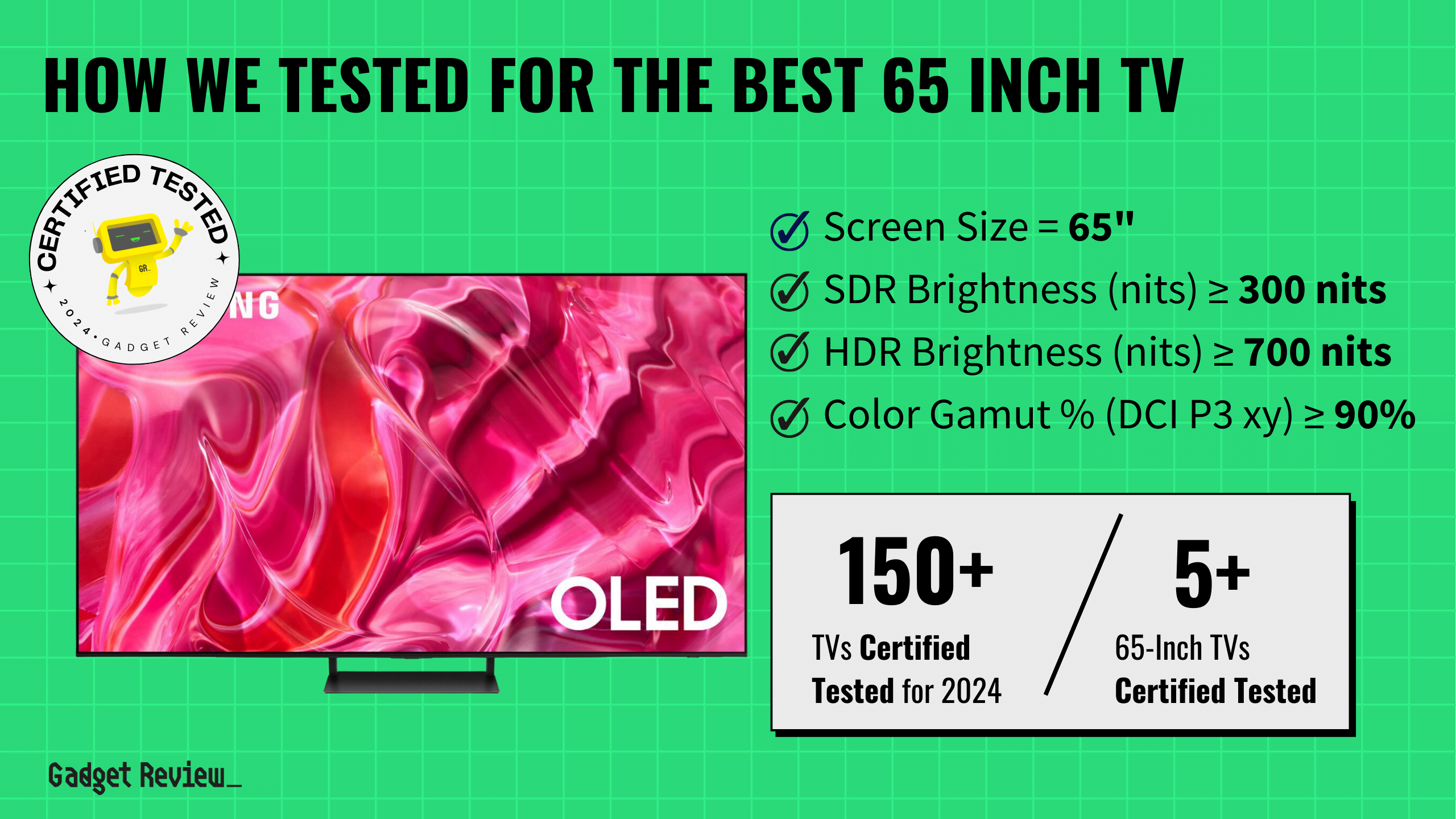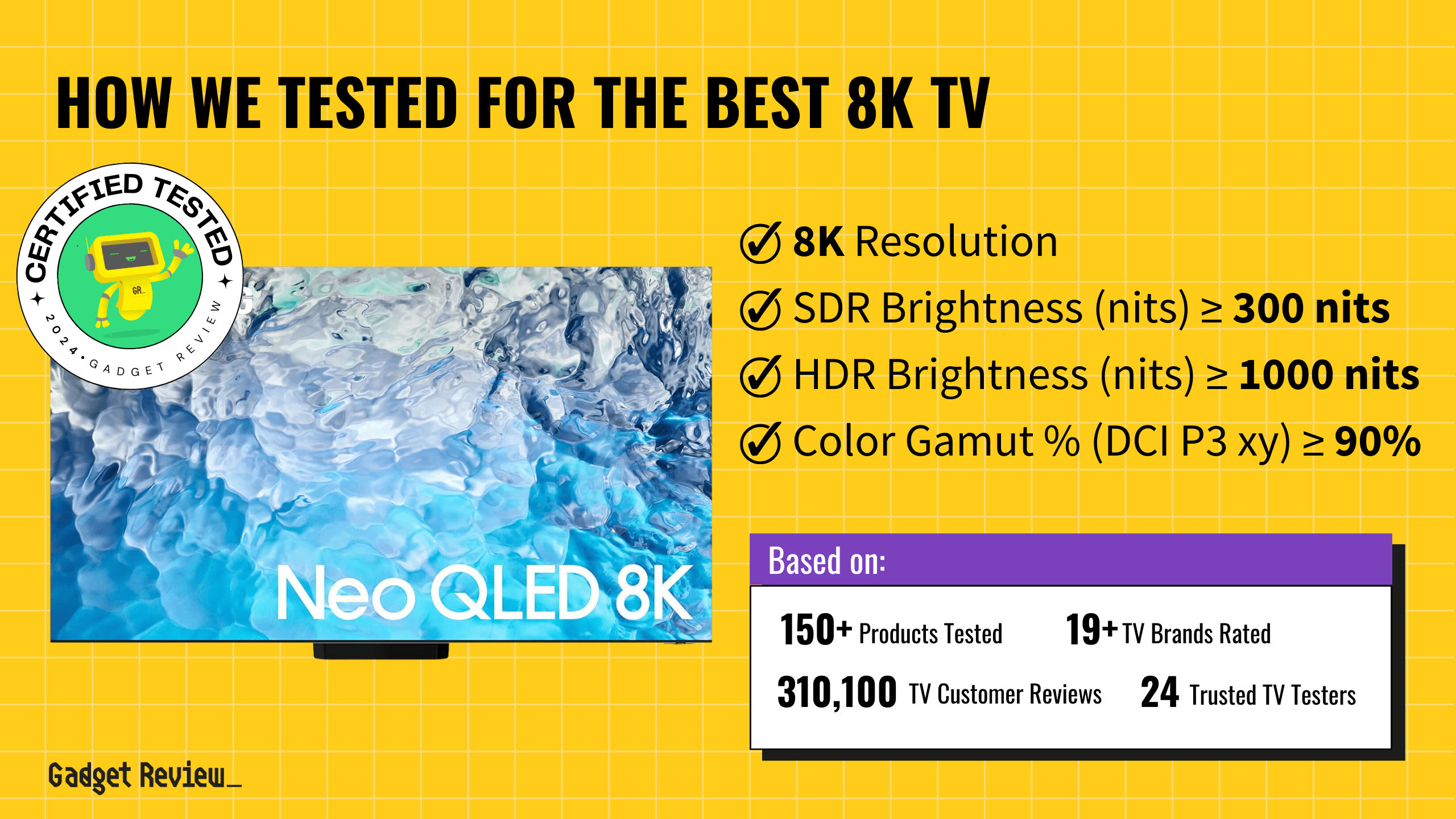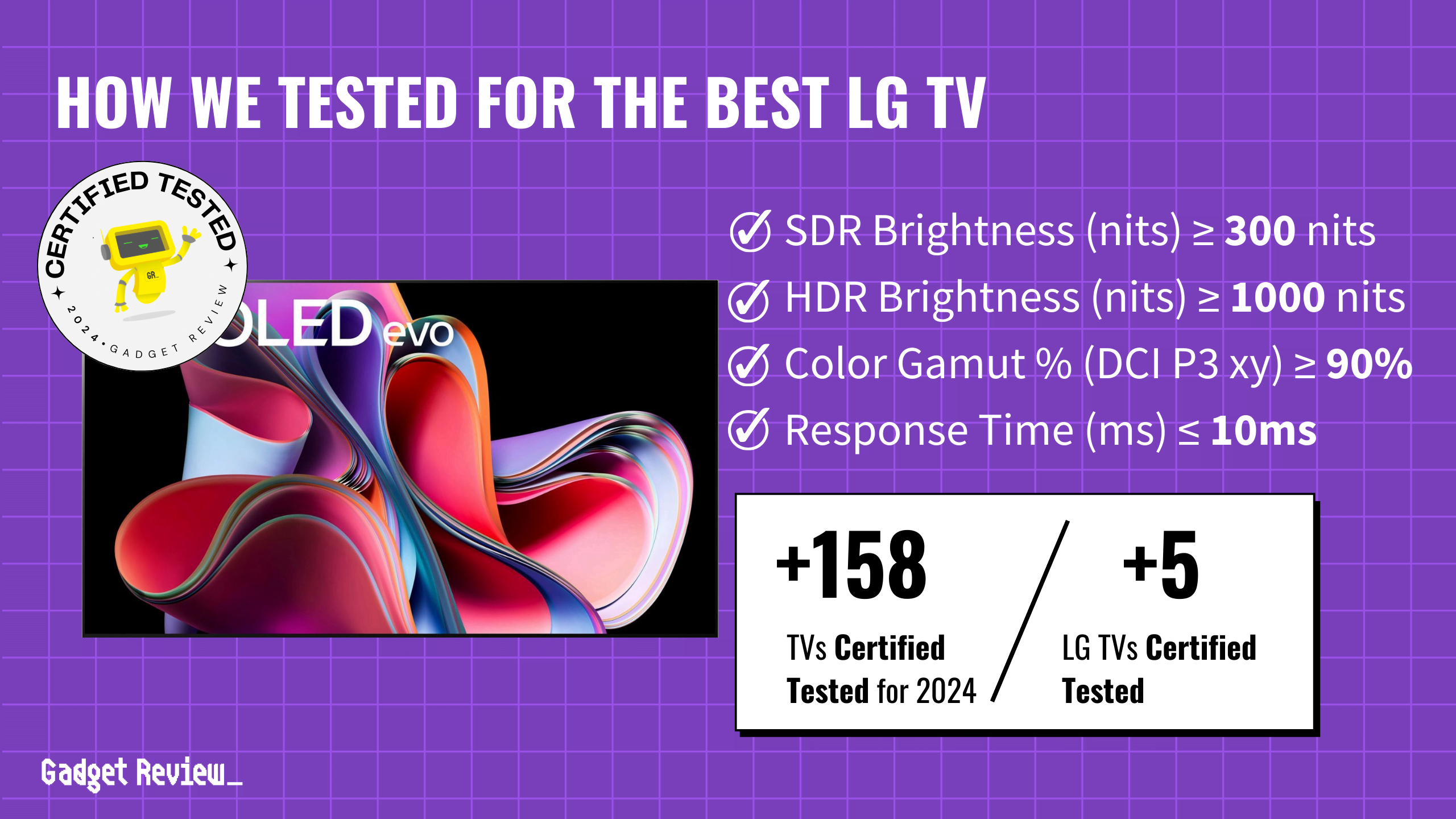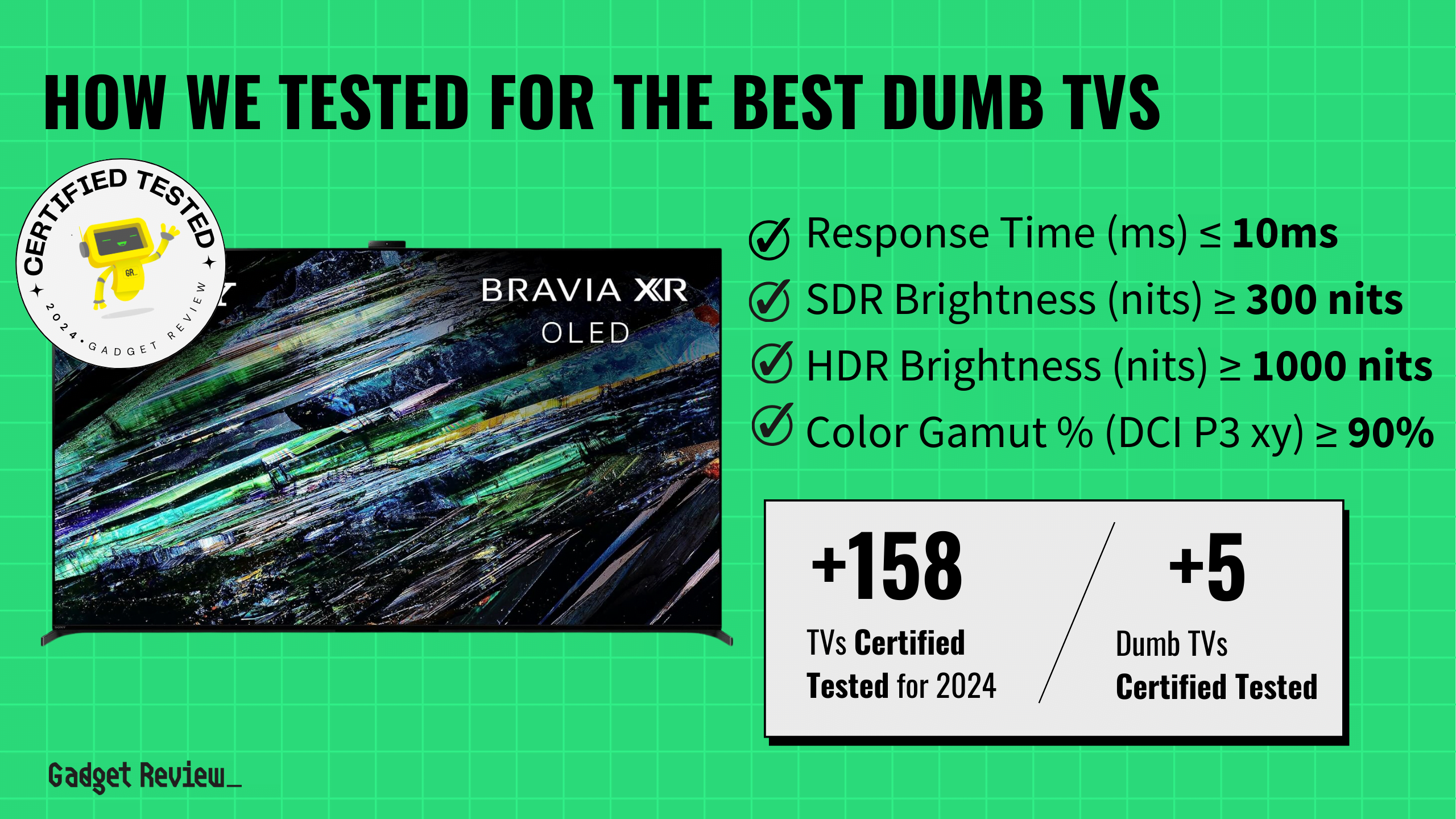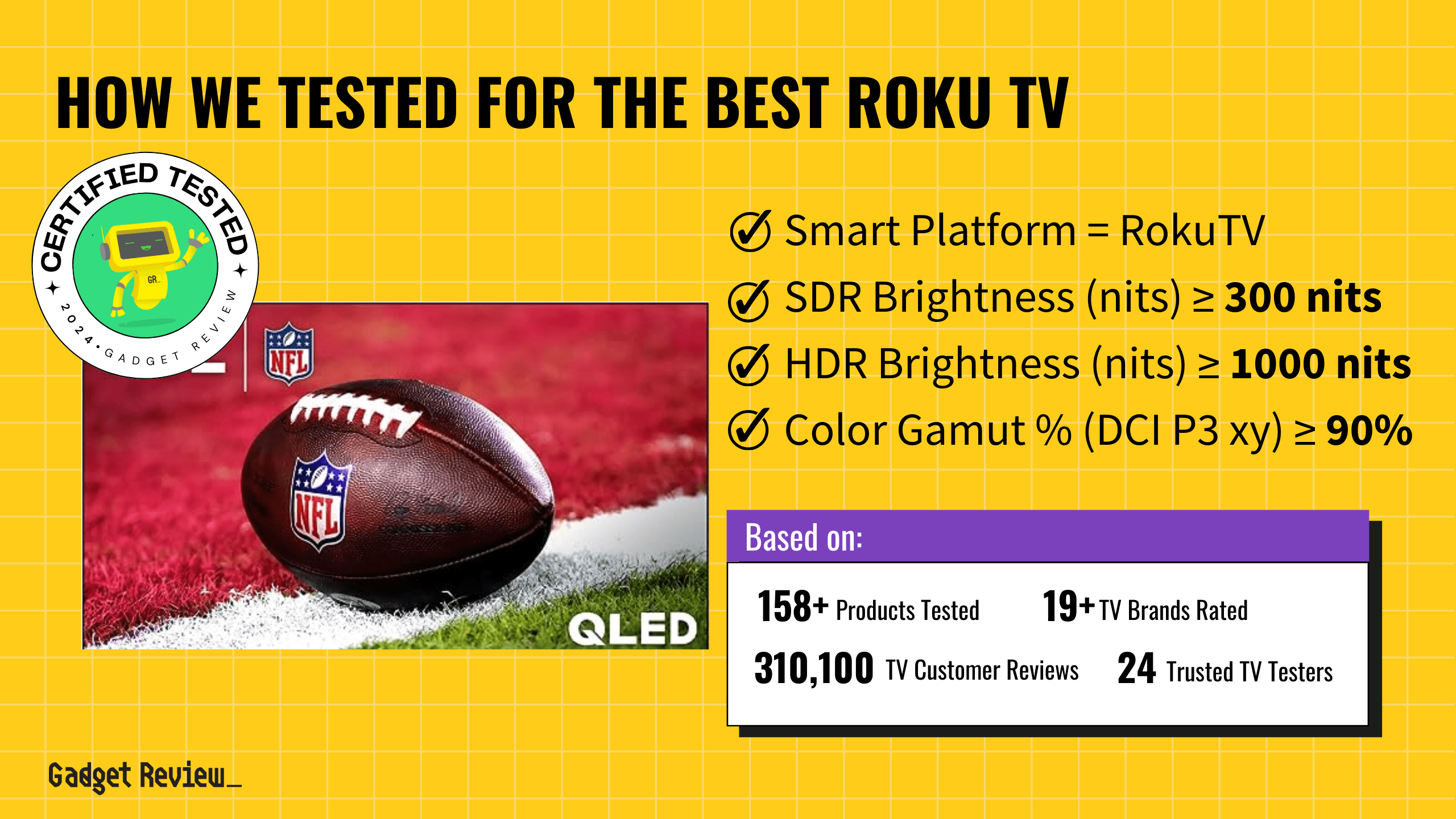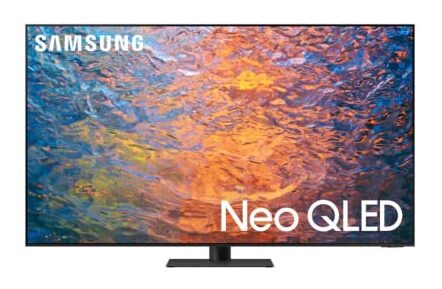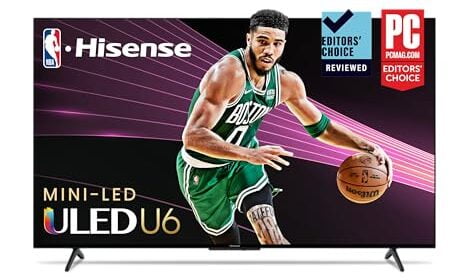Our guide to the best 65-inch TVs covers all budget ranges, from budget-friendly to premium, with a variety of technologies to support gaming, movie watching, sports viewing, or bright room settings.
Each recommendation is backed by solid test data, ensuring you make the perfect choice for your viewing preferences. Whether you’re on a tight budget or seeking top-tier features, you’ll find a top-notch TV that meets your needs without sacrificing quality.


TL;DR
When you shop through our links, you’re backing our mission.
🎮 Grab the Samsung S90C for the fastest response time, best for live sports.
🎬 Select the Samsung S95C with the sharpest EOTF, perfect for home theaters.
📺 Choose the LG B3 if you want OLED quality at a lower price, great for movies.
🌟 Choose the TCL QM8 if brightness trumps all, even outshining the Hisense U8K.
🏆 Definitely pick the Hisense U7K for top value, ideal for budget-friendly setups.
🌞 Opt for the Hisense U8K over the LG B3 for superior brightness, ideal for any room.
How Did We Rank the Best 65 Inch TVs?
To assess how high or low quality a 65-inch TV actually is, one must evaluate specific testing criteria against reference industry standards. Using our thorough TV Testing Methodology, we determined there are 1 minimum specs and 6 criteria below (3 required, 3 nice to have) that ensure your 65 Inch TV looks as good as the creator intended it.
?️ Minimum Specifications
- Size: 65 inches, providing an immersive viewing experience.
? Test Criteria
- SDR Brightness: Must meet or exceed 300 nits to ensure clear picture quality under standard lighting conditions.
- HDR Brightness: 700 nits or more, to reveal the finest details in high dynamic range content.
- Color Accuracy: Must cover at least 90% of the DCI P3 color gamut for vibrant and lifelike colors.
? “Nice To Haves”
- Contrast Ratio: Achieve a contrast ratio of at least 10,000:1 for deep blacks and bright whites, enhancing overall picture quality.
- EOTF Accuracy: Delta of 0.018 or less to maintain precise brightness and contrast levels across different content.
- Fast Response Time: Response time of 10ms or less for smooth motion and reduced blur in fast-paced scenes.
We’ve redefined TV buying guides, setting us apart from any other site on the planet. Our unique approach combines in-house verification with a comprehensive dataset from over 200+ trusted sites, focusing on key testing metrics to rank the top rated 65 Inch TVs. Testing data and specs include brightness (300 nits and 700 nits), minimum 90% DCI P3 color gamut, and a screen size of 65 inches. In this case, it’s about delivering an immersive viewing experience, ensuring vibrant colors and optimal brightness, all while providing ample screen real estate. Discover our data-driven methodology for precise, reliable TV recommendations. Our commitment to unbiased reviews is powered by our ‘True Score’ system, targeting low quality and fake reviews. Commissions fund this mission. No bias. No BS.
Latest Updates
- 03/05/2024: Completely and thoroughly overhauled the guide to include the best and latest 65-inch TVs.
- 11/30/2023: Republished the list to include TVs based on our True Score system.
Top 65 Inch TVs For 2025
Prices accurate at the time of publishing
To snag a spot on our list, a 65-inch TV needs to be an all around great TV that performs for movies, gaming and even daily TV watching.

Best Overall

Runner Up

Best Value

Best Budget

Best Mid-Range

Premium Pick
Samsung S90C TV
The Samsung S90C sets the standard for 65-inch TVs with its remarkable contrast, expansive viewing angles, and superior color fidelity, offering peak performance and value.
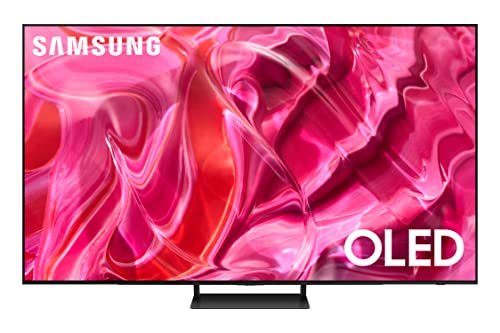
True Score
91938Experts
935kCustomers
Cosmic Wonder
 SAVE $500$1,499.99$999.99
SAVE $500$1,499.99$999.99Read More
Snapshot
Reasons to Buy
- Excellent picture quality
- The near-infinite contrast ratio for perfect blacks
- High peak brightness
- Exceptionally wide viewing angle
- Low input lag/Response time
- Sharp upscaling
Reasons to Avoid
- Aggressive Auto Brightness Limiter (ABL)
- No support for DTS or Dolby Vision
Specifications
Max Resolution 3840 x 2160 (4k) 
Backlight Type n/a Refresh Rate 120 Hz, 144 Hz Display Type OLED HDMI Inputs 4 
HDMI Type HDMI 2.1 HDR Format HDR10+, HLG 
HomeKit Compatible No 
Number of Audio Channels 2.1 
Panel Type OLED Screen size 55″, 65″, 75″, 83″ 
Smart Platform Tizen 
Speaker Output 40 Watts 
Sync Technology AMD FreeSync Premium 
VRR Yes All Specs
Test Results
SDR Brightness (nits) 373 HDR Brightness (nits) 1,058 Color Gamut % (DCI P3 xy) 99.975 Response Time (ms) 1.4 Contrast Ratio (x:1) 0 EOTF (600 nit delta) 0.0031 Color Gamut % (DCI P3 uv) 99.95 Color Gamut % (Rec 2020 xy) 86.37 Color Gamut % (Rec 2020 uv) 91.59 Color Gamut % (sRGB) 0 Color Gamut % (Rec 709) 0 Color Gamut % (BT.2020) 76 Color Gamut % (Adobe RGB) 0 Color Gamut % (BT.709) 0 Input Lag (ms) 8.5 Color Washout (Degrees) 70 Color Shift (Degrees) 70 Brightness Loss (Degrees) 70 Reflections (%) 1.2 Low-Freq Extension (Hz) 84.76 Freq Response StdDev @ 70db 2.8 Freq Response StdDev @ 80db 3.63 Weighted Total Harmonic Distortion @80db 0.133 Intermodulation Distortion @80db 2.47 EOTF (1000 nit delta) 0.0036 EOTF (4000 nit delta) 0.0024 All Tests
All Retailers
- $999.99$1,500Save $500
Availability
In StockFree Shipping
No - $1,099.00$1,398Save $299
Availability
In StockFree Shipping
No - $1,329.00$2,598Save $1,269
Availability
In StockFree Shipping
No
Our Verdict
The Samsung S90C is a standout choice, offering superior performance at a more mid-range price point, and is one of the best 65-inch TVs you can buy. Its OLED technology ensures unmatched contrast and wide viewing angles, bolstered by an unparalleled color gamut of 99.98%. Although it doesn’t lead in brightness, with SDR at 373 nits and HDR at 1058 nits, it excels in providing clear, vivid imagery in most lighting conditions without glare.
Its best-in-class 1.4 ms response time is perfect for capturing the intensity of live sports without any blur. This pairs well with the S90C’s 8.5 ms input lag to provide a seamless, responsive experience for competitive gamers, ensuring no detail or input is missed in fast-paced action. Additionally, its exceptional EOTF performance highlights its capability as a prime choice for home theaters, promising accurate gamma tracking for a true-to-life picture.
In the realm of 65-inch TVs, the S90C is an exemplary option for diverse entertainment needs, particularly gaming, but also movies and sports, performing exceptionally well in environments that aren’t overly bright.
Read Less

Best Overall

Runner Up

Best Value

Best Budget

Best Mid-Range

Premium Pick
Samsung S95C OLED TV
The S95C excels in color precision and luminosity, catering to gamers and viewers in any light setting with its luxurious features and flexible performance, but at a premium price.
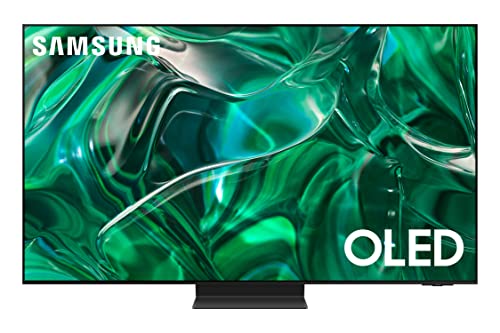
True Score
899215Experts
90724Customers
Absolutely Fresh
 SAVE $100$1,897.99$1,797.95
SAVE $100$1,897.99$1,797.95Read More
Snapshot
Reasons to Buy
- Excellent image quality
- Produces great bright colors and deep blacks
- Exceptionally wide viewing angle
- Incredibly low input lag
Reasons to Avoid
- Aggressive ABL
Specifications
Max Resolution 3840 x 2160 (4k) 
Backlight Type No Refresh Rate 120 Hz, 144 Hz Display Type OLED HDMI Inputs 4 
HDMI Type HDMI 2.1 HDR Format HDR10+, HLG 
HomeKit Compatible No 
Number of Audio Channels 4.2.2 
Panel Type QD-OLED Screen size 55″, 65″, 77″ 
Smart Platform Tizen 
Speaker Output 70 Watts 
Sync Technology AMD FreeSync, AMD FreeSync Premium Pro 
VRR Yes All Specs
Test Results
SDR Brightness (nits) 704 HDR Brightness (nits) 1,383 Color Gamut % (DCI P3 xy) 99.81 Response Time (ms) 5.5 Contrast Ratio (x:1) 0 EOTF (600 nit delta) 0.0029 Color Gamut % (DCI P3 uv) 99.53 Color Gamut % (Rec 2020 xy) 84.99 Color Gamut % (Rec 2020 uv) 89.78 Color Gamut % (sRGB) 0 Color Gamut % (Rec 709) 141.5 Color Gamut % (BT.2020) 75 Color Gamut % (Adobe RGB) 0 Color Gamut % (BT.709) 0 Input Lag (ms) 8.3 Color Washout (Degrees) 70 Color Shift (Degrees) 70 Brightness Loss (Degrees) 70 Reflections (%) 1 Low-Freq Extension (Hz) 106.79 Freq Response StdDev @ 70db 2.45 Freq Response StdDev @ 80db 2.41 Weighted Total Harmonic Distortion @80db 0.511 Intermodulation Distortion @80db 0.511 EOTF (1000 nit delta) 0.0025 EOTF (4000 nit delta) 0.0022 All Tests
All Retailers
- $1,797.95$1,898Save $100
Availability
In StockFree Shipping
No - $1,899.99$2,300Save $400
Availability
In StockFree Shipping
No
Our Verdict
The Samsung S95C stands out as an excellent option if you’re looking for a more premium 65-inch set that also excels in color accuracy and luminance. Its remarkable 99.81% DCI P3 color gamut and unrivaled brightness levels, with SDR at 704 nits and HDR peaking at 1383 nits, ensure it delivers stunning visuals under any lighting conditions. Ideal for immersive home theater setups or well-lit living spaces, its versatility is unmatched.
While its 5.5 ms response time ensures smooth playback for dynamic scenes in movies and sports, it remains competitive for gaming thanks to its leading 8.3 ms input lag. This combination positions the S95C as a top choice for gamers seeking a competitive edge.
The S95C’s outstanding EOTF performance (the best among the OLEDs listed here) of 0.0029, guarantees precise home theater content reproduction, whether in dim or brightly lit environments. Its adaptability across various viewing scenarios is held back only by its premium pricing, making it an excellent and expensive choice for those desiring the best 65-inch TV experience.
Read Less

Best Overall

Runner Up

Best Value

Best Budget

Best Mid-Range

Premium Pick
LG B3 OLED TV
An affordable OLED, the LG B3 delivers deep blacks, broad viewing angles, and rich colors, providing premium OLED benefits at an unbeatable price.
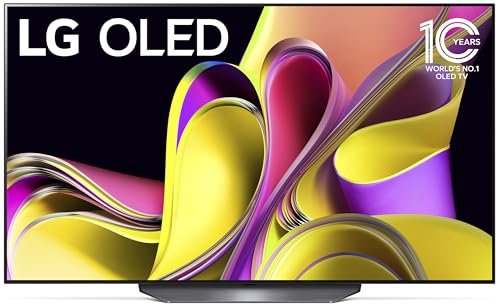
True Score
87874Experts
922kCustomers
Absolutely Fresh
 SAVE $90$1,186.95$1,096.95
SAVE $90$1,186.95$1,096.95Read More
Snapshot
Reasons to Buy
- Excellent picture quality
- Great Contrast
- High-performance motion handling
- Fast refresh rate
- Wide Viewing Angles
Reasons to Avoid
- Below Average Brightness
- Aggressive ABL
- Mediocre speaker sound quality
Specifications
Max Resolution 3840 x 2160 (4k) 
Backlight Type n/a Refresh Rate 120 Hz Display Type OLED HDMI Inputs 4 
HDMI Type HDMI 2.1 HDR Format Dolby Vision 
HomeKit Compatible Yes 
Number of Audio Channels 2.1 
Panel Type OLED Screen size 55″, 65″, 77″ 
Smart Platform webOS 
Speaker Output 20 Watts 
Sync Technology AMD FreeSync Premium, G-Sync 
VRR Yes All Specs
Test Results
SDR Brightness (nits) 390 HDR Brightness (nits) 617 Color Gamut % (DCI P3 xy) 98.345 Response Time (ms) 3.1 Contrast Ratio (x:1) 0 EOTF (600 nit delta) 0.0067 Color Gamut % (DCI P3 uv) 99.62 Color Gamut % (Rec 2020 xy) 73.09 Color Gamut % (Rec 2020 uv) 77.66 Color Gamut % (sRGB) 0 Color Gamut % (Rec 709) 0 Color Gamut % (BT.2020) 73.14 Color Gamut % (Adobe RGB) 0 Color Gamut % (BT.709) 0 Input Lag (ms) 11.7 Color Washout (Degrees) 64 Color Shift (Degrees) 31 Brightness Loss (Degrees) 70 Reflections (%) 1.4 Low-Freq Extension (Hz) 84.76 Freq Response StdDev @ 70db 3.64 Freq Response StdDev @ 80db 3.67 Weighted Total Harmonic Distortion @80db 0.165 Intermodulation Distortion @80db 8.25 EOTF (1000 nit delta) 0.0035 EOTF (4000 nit delta) 0.0037 All Tests
All Retailers
- $1,096.95$1,187Save $90
Availability
In StockFree Shipping
No - $1,099.00$2,400Save $1,301
Availability
In StockFree Shipping
No - $1,196.99$2,397Save $1
Availability
In StockFree Shipping
- $1,199.99$1,300Save $100
Availability
In StockFree Shipping
No
Our Verdict
If you’re eyeing a budget-friendly 65-inch TV without compromising on quality, the LG B3 is your best bet. Its OLED display provides deep blacks and wide viewing angles like any other OLED, and features a 98.35% DCI P3 color gamut. This gives the B3 excellent color coverage and accuracy despite the more budget price point, and its EOTF of 0.0067 cements it as a fantastic home theater centerpiece.
Though its brightness, at 390 nits for SDR and 617 nits for HDR, doesn’t lead the pack, it’s sufficient for most home settings, barring overly bright environments. The B3’s outstanding 3.1 ms response time ensures action scenes and sports are blur-free, offering clarity that rivals more costly models. Coupled with an 11.7 ms input lag, it’s also a solid choice for casual gaming and can even hang with some hardcore competitive gamers looking for a budget OLED.
Overall, the LG B3 represents exceptional value, marrying OLED technology’s perks with a price to performance ratio that none of the other OLEDs on our list can match. It’s the smart choice for anyone wanting premium OLED benefits — like infinite contrast and excellent color accuracy — without the premium price tag, making it ideal for a wide range of uses from cinematic viewing to gaming.
Read Less

Best Overall

Runner Up

Best Value

Best Budget

Best Mid-Range

Premium Pick
TCL QM8/QM850G QLED TV
The TCL QM8 shines as the brightest option for sunlit spaces, with unmatched SDR and HDR brightness, fast response for sports, and QLED color vibrancy, offering superior visibility and quality at great value.
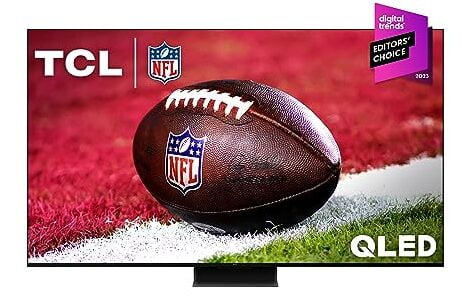
True Score
84847Experts
90478Customers
Absolutely Fresh
 SAVE $50$999.99$949.99
SAVE $50$999.99$949.99Read More
Snapshot
Reasons to Buy
- Outstanding picture quality
- Spectacular brightness and contrast ratio
- Rapid response time
- Super low input lag
Reasons to Avoid
- Disappointing viewing angles
Specifications
Max Resolution 3840 x 2160 (4k) 
Backlight Type Full-Array Refresh Rate 120 Hz 
Depth 11.7″ Display Type QLED HDMI Inputs (Total) 2 
HDMI Type HDMI 2.1 HDR Format Dolby Vision, HDR10, HDR10+, HLG 
Height 34.1″ High Dynamic Range (HDR) Yes 
Number of Audio Channels 3 
Panel Type LED Screen size 65″, 75″, 85″, 98″ 
Smart Platform Google TV 
Speaker Output 40 Watts 
Sync Technology AMD FreeSync Premium Pro 
VRR Yes 
Voice Assistant Google Assistant 
Weight 54.7 lbs 
Width 56.9″ 
Works With Amazon Alexa, Apple HomeKit, Google Assistant All Specs
Test Results
SDR Brightness (nits) 2,076 HDR Brightness (nits) 2,005 Color Gamut % (DCI P3 xy) 94.59 Response Time (ms) 8.9 Contrast Ratio (x:1) 114,057 EOTF (600 nit delta) 0.037 Color Gamut % (DCI P3 uv) 97.31 Color Gamut % (Rec 2020 xy) 75.81 Color Gamut % (Rec 2020 uv) 80.57 Color Gamut % (sRGB) 0 Color Gamut % (Rec 709) 0 Color Gamut % (BT.2020) 0 Color Gamut % (Adobe RGB) 0 Color Gamut % (BT.709) 0 Input Lag (ms) 14.3 Color Washout (Degrees) 24 Color Shift (Degrees) 31 Brightness Loss (Degrees) 32 Reflections (%) 1.8 Low-Freq Extension (Hz) 89.8 Freq Response StdDev @ 70db 4.74 Freq Response StdDev @ 80db 4.67 Weighted Total Harmonic Distortion @80db 0.128 Intermodulation Distortion @80db 8.67 EOTF (1000 nit delta) 0.0238 EOTF (4000 nit delta) 0.0271 All Tests
All Retailers
- $949.99$1,000Save $50
Availability
In StockFree Shipping
No - $998.00$1,136Save $138
Availability
In StockFree Shipping
Yes - $1,299.00
Availability
In StockFree Shipping
Yes
Our Verdict
If you need unparalleled brightness for the brightest possible rooms and need a TV that delivers blur-free sports content, the TCL QM8 is ideal for the most luminous spaces. Featuring an SDR Brightness of 2076 nits and HDR Brightness of 2005 nits, it offers the brightest display on our list, guaranteeing that even the brightest rooms in the house won’t be able to drown out the picture on screen.
Though its input lag of 14.3 ms is tied for the highest among its peers, it remains adequate for casual gaming, particularly in well-lit areas. The QM8 does well in response time though, clocking in at 8.9 ms that, while middle of the road, is still great for watching fast-paced sports in sunny conditions without missing a beat.
As a budget option, the TCL QM8 competes most with the Hisense U8K. The two have very similar performance and nearly identical price tags, but the QM8 can’t be beat when it comes to brightness. If you need a 65-inch TV and that must be as bright as possible, the QM8 beats not only the U8K, but every other TV on our list, hands down.
Read Less

Best Overall

Runner Up

Best Value

Best Budget

Best Mid-Range

Premium Pick
Hisense U7K
The Best Value option, the U7K blends commendable color, sufficient brightness, and smooth gaming into an attractively priced package.
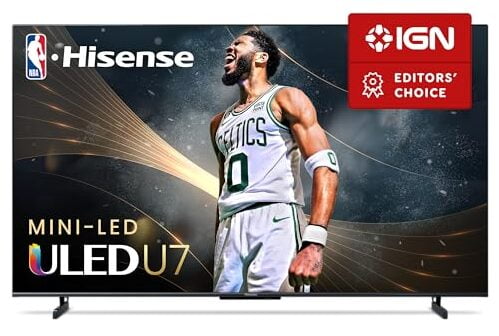
True Score
83859Experts
87522Customers
Absolutely Fresh
 SAVE $40$799.99$759.99
SAVE $40$799.99$759.99Read More
Snapshot
Reasons to Buy
- Outstanding picture quality in the dark
- High peak brightness
- Fast response time and low input lag
- 120 Hz refresh rate
Reasons to Avoid
- Subpar off-center viewing
- Average blooming
Specifications
Max Resolution 3840 x 2160 (4k) 
Backlight Type Full-Array Refresh Rate 120 Hz Display Type LED HDMI Inputs 4 
HDMI Type 2.0, HDMI 2.1 HDR Format Dolby Vision, HDR10, HDR10+, HLG 
HomeKit Compatible – 
Number of Audio Channels 2.1 
Panel Type IPS Screen size 55″, 65″, 75″ 
Smart Platform Google TV 
Speaker Output 40 Watts 
Sync Technology HDR Format 
VRR Yes All Specs
Test Results
SDR Brightness (nits) 603 HDR Brightness (nits) 786.5 Color Gamut % (DCI P3 xy) 96.31 Response Time (ms) 11.3 Contrast Ratio (x:1) 45,000 EOTF (600 nit delta) 0.0211 Color Gamut % (DCI P3 uv) 97.4 Color Gamut % (Rec 2020 xy) 76.18 Color Gamut % (Rec 2020 uv) 81.91 Color Gamut % (sRGB) 98.5 Color Gamut % (Rec 709) 0 Color Gamut % (BT.2020) 76 Color Gamut % (Adobe RGB) 80.5 Color Gamut % (BT.709) 0 Input Lag (ms) 14.3 Color Washout (Degrees) 23 Color Shift (Degrees) 23 Brightness Loss (Degrees) 35 Reflections (%) 1.9 Low-Freq Extension (Hz) 89.8 Freq Response StdDev @ 70db 4.36 Freq Response StdDev @ 80db 4.48 Weighted Total Harmonic Distortion @80db 0.096 Intermodulation Distortion @80db 4.47 EOTF (1000 nit delta) 0.021 EOTF (4000 nit delta) 0.013 All Tests
All Retailers
- $759.99$800Save $40
Availability
In StockFree Shipping
No - $800.00
Availability
In StockFree Shipping
No - $931.08
Availability
In StockFree Shipping
No
Our Verdict
If budget is the biggest determining factor for 65-inch TVs you’re considering, the Hisense U7K may be what you’re looking for, offering good performance while also being one of the Best Value TVs on the list. Its 94.59% DCI P3 color gamut ensures commendable color fidelity and pairs well with a good contrast ratio that reaches north of 45,000.
However, the U7K is not without its compromises – its SDR and HDR brightness of 603 nits and 786.5 nits respectively, struggle to beat even OLEDs. However, it’s also anywhere from a third to half as much the price of an OLED TV. This makes it adequately bright for most settings except very bright rooms.
With a response time of 11.3 ms and an input lag of 14.3 ms, the U7K is perfectly suited for casual gaming and general sports viewing, offering a responsive enough experience even if it’s not the first pick for competitive gamers.
Ultimately, the Hisense U7K is notable for its excellent price-performance ratio, offering solid color accuracy, sufficient brightness, and responsive enough gameplay in a budget-friendly package. It doesn’t excel in any one category, but it does well enough in each of them to make its low price that much sweeter.
Read Less

Best Overall

Runner Up

Best Value

Best Budget

Best Mid-Range

Premium Pick
Hisense U8K TV
The U8K features excellent brightness and strong all-around performance for a non-OLED TV, making it ideal for any viewing material in most viewing conditions.
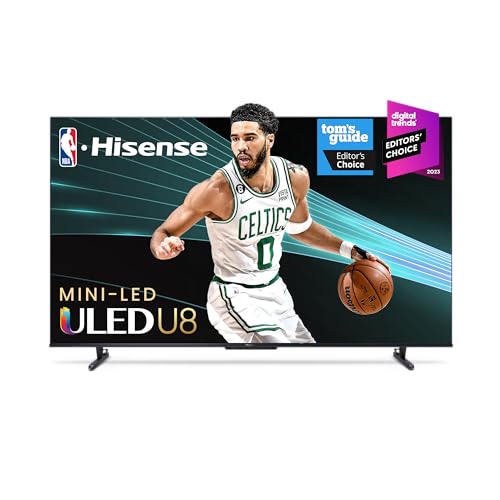
True Score
80806Experts
851kCustomers
Absolutely Fresh
 SAVE $150$999.99$849.99
SAVE $150$999.99$849.99Read More
Snapshot
Reasons to Buy
- Good picture quality
- Outstanding brightness and good contrast ratio
- Quick response time
- Great reflection handling
Reasons to Avoid
- Poor viewing angles
Specifications
Max Resolution 3840 x 2160 (4k) 
Backlight Type Full-Array Refresh Rate 144 Hz 
Depth 3″ Display Type LED HDMI Inputs (Total) 4 
HDMI Type HDMI 2.1 HDR Format Dolby Vision, HDR10, HDR10+, HLG 
Height 33.1″ High Dynamic Range (HDR) Yes 
Number of Audio Channels 2.1.2 
Panel Type VA Screen size 100″, 55″, 65″, 75″, 85″ 
Smart Platform Google TV 
Speaker Output 50 Watts 
Voice Assistant Google Assistant 
Weight 56.4″ lbs 
Width 57.2″ 
Works With Google Assistant All Specs
Test Results
SDR Brightness (nits) 1,549 HDR Brightness (nits) 1,792 Color Gamut % (DCI P3 xy) 97.44 Response Time (ms) 13.3 Contrast Ratio (x:1) 165,360 EOTF (600 nit delta) 0.0105 Color Gamut % (DCI P3 uv) 97.01 Color Gamut % (Rec 2020 xy) 76.18 Color Gamut % (Rec 2020 uv) 81.82 Color Gamut % (sRGB) 0 Color Gamut % (Rec 709) 0 Color Gamut % (BT.2020) 80 Color Gamut % (Adobe RGB) 0 Color Gamut % (BT.709) 0 Input Lag (ms) 14.2 Color Washout (Degrees) 23 Color Shift (Degrees) 23 Brightness Loss (Degrees) 35 Reflections (%) 1.8 Low-Freq Extension (Hz) 80 Freq Response StdDev @ 70db 2.06 Freq Response StdDev @ 80db 2.11 Weighted Total Harmonic Distortion @80db 0.1 Intermodulation Distortion @80db 0.71 EOTF (1000 nit delta) 0.0106 EOTF (4000 nit delta) 0.011 All Tests
All Retailers
- $849.99$1,000Save $150
Availability
In StockFree Shipping
No - $997.99
Availability
In StockFree Shipping
No - $1,500.18
Availability
In StockFree Shipping
No
Our Verdict
If you’re looking for a bright display at a budget price that can also handle home theater content, the Hisense U8K stands out. With an incredible SDR and HDR brightness at 1549 and 1792 nits, it lights up any room from sun-drenched spaces to dimly lit corners. Its superior luminance, coupled with an EOTF of 0.0105, positions it as an exceptional pick for home theater enthusiasts seeking clarity and vividness in every scene without having to shell out for OLED prices.
With a 97.44% DCI P3 color gamut, the U8K offers impressive color accuracy, especially for the money. Its response time of 13.3 ms helps reduce motion blur, though it’s not the quickest on our list, but is still enough to keep sports from becoming a blurry mess. The 14.2 ms input lag, on the other hand, means it’s not ideal for competitive gamers, but is still responsive enough for casual gaming.
Highlighting its strong value, the U8K delivers this remarkable brightness and reliable performance at a cost that undercuts many OLED competitors. This mix of affordability, good gamma accuracy, and exceptional brightness makes the Hisense U8K a compelling option for those seeking a 65-inch TV that can be used in very bright rooms for just about anything.
Read Less

Our Approach to Testing 65-Inch TVs
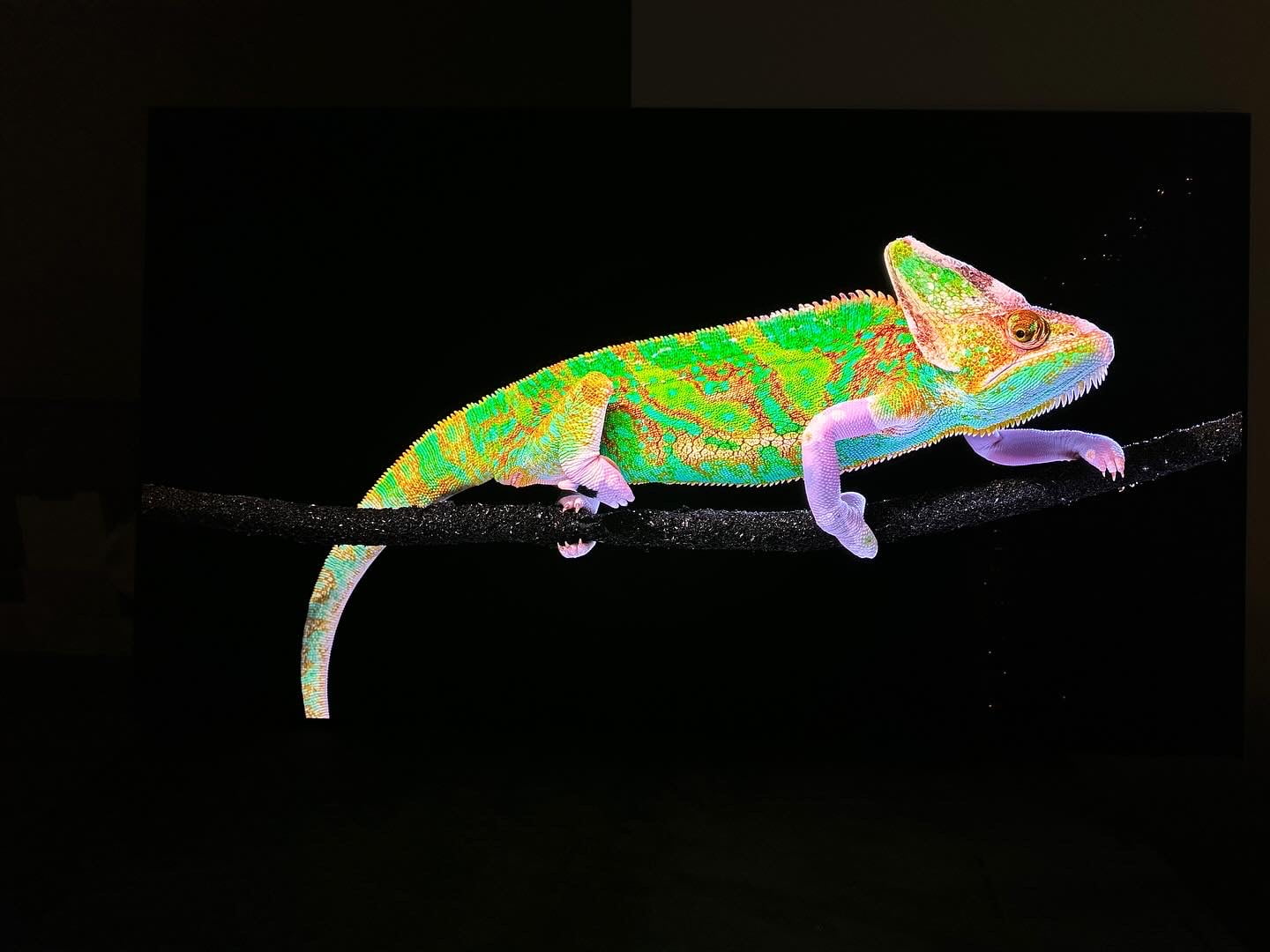
Evan Shepard/Gadget Review
We’ve redefined TV buying guides, setting us apart from any other site on the planet. Our unique approach combines in-house verification with a comprehensive dataset from trusted sites, focusing on key testing metrics like brightness (SDR and HDR), EOTF, response time, contrast ratio and color gamut.
We compile and scrutinize this data meticulously to ensure our recommendations perfectly align with individual needs. Particularly regarding 65-inch TVs, this entails curating models that excel in delivering exceptional image quality at this size, encompassing features like vibrant color accuracy, high brightness levels, and seamless upscaling of lower-resolution content. Uncover our meticulously crafted data-driven approach for accurate and dependable TV recommendations.
You may notice some of our graphs contain “Source: RTings”. This is to indicate that the data we’re showing off in a graph has come from a single source – because it’s the only source that actually tested the criteria and had data for it! Normally, our data is an average out of all of the various publications that test and provide data to give you a good idea of how a product is going to perform on average.
Which Criteria Matters for Testing 65 Inch TVs?
By focusing on these criteria (3 required, 3 nice to have), anyone can quickly and easily compare these TVs and how they’ll perform. This helps you make an informed decision and purchase a TV that will fit into your small or tight space.
| CRITERIA | RANGE | REQUIRED | DEFINITION |
|---|---|---|---|
| SDR Brightness | 300+ nits | Yes | Assess the luminance of your display when operating in Standard Dynamic Range (SDR) mode. |
| HDR Brightness | 700+ nits | Yes | Determine the luminance of your display in High Dynamic Range (HDR) mode. |
| Color Gamut (DCI P3 xy) | >= 90% | Yes | Evaluate the extent to which a TV can reproduce a specified spectrum of colors. |
| EOTF | 0.018 | No (nice to have) | Standard that governs how a display interprets and renders brightness and color. |
| Response Time | <=10ms | No (nice to have) | Time required for a pixel to transition from one color to another and then return to its original color. |
| Contrast Ratio | >= 10,000 | No (nice to have) | The ratio between the brightest white and darkest black that the screen can display. |
Our Trusted Data Sources
(Publication category Score is 80%+)
We looked at 210+ TV reviewers and while 24 are trustworthy (60%+ Trust Rating), we only use data from the testers that are “very trusted” which means a Trust Rating above 70%. The three we have listed below are our most trusted for TVs, along with our own in-house TV expert.
- Evan Shepard – Gadget Review
- Matthew Lopes – RTings, MuckRack
- Will Greenwald – PCMag, MuckRack, Twitter
- David Katzmaier – CNET, MuckRack, Twitter
Interested in a comprehensive analysis of our data sources? We’ve got you covered. Below, you’ll find a detailed list of every TV review website we’ve identified, organized by their respective Trust Ratings from highest to lowest. But we didn’t stop there. We’ve meticulously reviewed each publication and verified the data by checking whether the authors have bio links to MuckRack or LinkedIn. We’re committed to not only checking the facts but ensuring their veracity.
Best 65 Inch TVs Test Data & Results
1. SDR & HDR Brightness TV Test Results
In well-lit rooms, the brightness level of your 65-inch TV, quantified in nits, is key to a great viewing experience. A TV that doesn’t meet the brightness requirement will struggle against natural and artificial light, resulting in a dim, lackluster image. Essentially, nits measure how well your TV can stand up to light interference, with higher values ensuring a sharper, more vivid display.
For standard viewing on the best 65-inch TV, you should look for at least 300 nits to strike the right balance between clarity and color quality in standard dynamic range (SDR) content. For high dynamic range (HDR) content, which offers richer colors and greater contrast, a minimum of 700 nits is ideal to truly appreciate the enhanced visuals. These brightness levels are recommended to ensure your TV performs well in bright settings, allowing you to enjoy your shows and movies without any loss in detail or quality. Aim for these minimums: SDR Brightness >= 300 nits; HDR Brightness >= 700 nits for the optimal experience.
Discover the top 65-inch TVs, ranked from brightest to least.
Brightness
SDR: 300+ nits
HDR: 700+ nits
Acceptable range of performance
Definition: Maximum brightness in a specified pattern size window. Most commonly measured in a 10% or 100% white window.
Units of Measurement: nits (alternatively cd/m²)
Tools to Measure: TV, luminance meter
Why It’s Important:
Brightness helps counter ambient light so that details and colors don’t wash out and get lost.
SDR Brightness (in nits, higher is better)
HDR Brightness (in nits, higher is better)
2. Color Gamut (DCI P3 xy) TV Test Results
Color Gamut
>= 90%
Acceptable range of performance
Definition: The TV’s capability to display a spectrum of colors.
Units of Measurement: % (color space coverage in percent)
Tools to Measure: Colorimeter
Why It’s Important:
Inaccurate colors compromise the authenticity of the content.
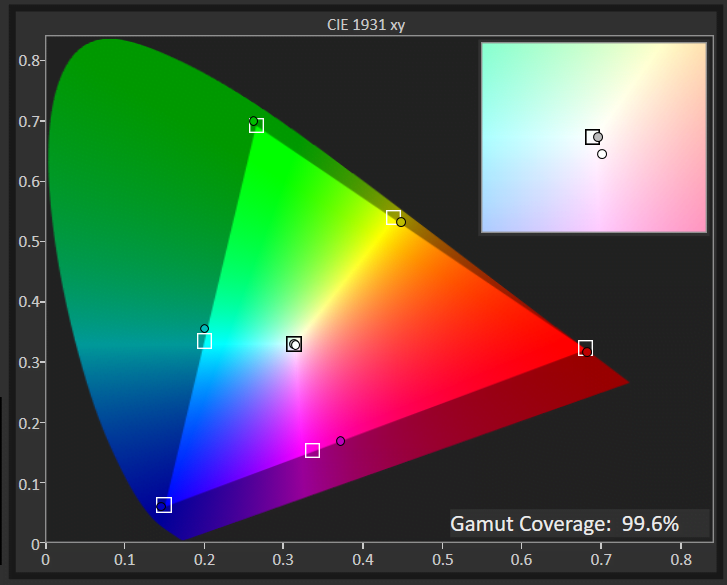
Color gamut defines the range of colors a TV can reproduce, directly affecting how vibrant and true-to-life the images look. A wide color gamut in a TV brings out richer, more vivid colors – from the lush greens of a garden to the bright colors of animated characters, enhancing your viewing experience to closely mimic real life.
This concept is technically measured against standards like the DCI P3 xy, a benchmark for high-quality visuals. A 65-inch TV covering a higher percentage of this color space can display colors more accurately and vividly.
For those who prioritize vibrant and immersive visuals, aiming for a 65-inch TV with a color gamut of 90% or higher on the DCI P3 xy scale is ideal. This ensures that the content you watch is as vibrant and lifelike as possible, providing the immersive large-screen viewing experience you desire.
Below are the top 65-inch TVs, ordered by color gamut, all exceeding our testing criteria.
DCI P3 XY Color Gamut (as a %; high is better)
3. EOTF Test Results
The Electro-Optical Transfer Function (EOTF) plays a critical role in ensuring the content on your TV looks exactly as the creator intended. This technical feature adjusts your screen’s brightness levels, ensuring every scene, from the darkest shadows to the brightest highlights, is displayed with true-to-life accuracy.
In rooms flooded with light, a TV that nails EOTF calibration shines by preserving the intended contrast and detail in the picture despite the challenging conditions. It balances the brightness so that images remain vibrant and full of detail, unaffected by the glare of ambient light.
A TV that excels in managing EOTF offers an immersive and authentic viewing experience. It brings creators’ visions to life, accurately rendering every scene with the proper light and dark levels, no matter the lighting in your room. This means you get a consistent, realistic picture that captures the full spectrum of colors and contrasts, from the subtlest hues to the most intense explosions.
Below are all the 65-inch TVs on our list, ordered by EOTF, from best to worst.
EOTF
< 0.018 (600 nit Δ)
Acceptable range of performance
Definition: How your TV interprets and renders the luminance data from content and translates it to be represented on screen. If EOTF/Gamma tracking is too low or too high, it will result in an over-brightened or over-darkened image from reference.
Units of Measurement: this test measures for the delta from the standard
Tools to Measure: Luminance colorimeter
Why It’s Important:
EOTF ensures that the game is displayed (color and HDR brightness) as the creator intended it
EOTF (source: rtings.com – 0 = no data exists; lower is better)
4. Response Time TV Test Results
Response Time
1ms-10ms
Acceptable range of performance
Definition: Speed at which a pixel transitions from one color to another
Units of Measurement: milliseconds (ms)
Tools to Measure: Screen, camera, test software
Why It’s Important:
A faster response time means less blur and thus more accuracy
A slow response time on a 65-inch TV during fast-paced scenes is like trying to watch a thrilling movie with a foggy lens. Imagine settling in for an action-packed sequence, only to have the swift movements turn into a blur, robbing you of the crisp, clear detail you crave. This isn’t just a minor annoyance; it’s a major detriment to your viewing experience, leaving you with a picture marred by motion blur and visual artifacts.
So, what exactly is response time? It measures how quickly a pixel on your TV can change from one color to another. In the context of watching fast-moving content or enjoying dynamic scenes, a low response time is crucial. A response time of 15 ms or lower is good, but if you plan on gaming on this set, aim for a response time of 10 ms or lower. At these levels, your 65-inch TV ensures smooth transitions and sharp visuals, making every scene come to life without any distracting blurs or delays.
Below are the top 65-inch TVs, ordered by response time.
Response Time (in milliseconds; lower is better)
5. Contrast Ratio Test Results
For TV enthusiasts, a solid contrast ratio is crucial for enjoying your favorite TV shows or movies, especially in darker settings. This feature directly impacts how lifelike and dynamic the picture appears on your screen, ensuring that dark scenes are displayed with clear, crisp blacks instead of murky grays and bright scenes retain their detail without appearing washed out.
Put simply, the contrast ratio is all about the range of luminance a TV can produce, from the deepest blacks to the brightest whites. It’s what brings depth to the image, enhancing the realism of every scene. Watching a movie in the dark, for example, the difference between a TV with a poor contrast ratio and one with a high ratio is stark: the former struggles, blending shadows into a flat gray, while the latter delivers true black, making night scenes more immersive and detailed.
Ideally, a contrast ratio of 10,000:1 is what you should aim for in a small TV. This level of luminance variance ensures that you’re getting a picture quality that can handle the nuances of lighting in any scene, providing a viewing experience that’s both rich and engaging. Note: OLED TVs have infinite contrast ratio, indicated by “0.”
Below are the top 65-inch TVs, ordered by contrast ratio, all exceeding our testing criteria.
Contrast Ratio
>=10,000:1
Acceptable range of performance
Definition: Difference between the darkest black and the brightest white a screen can display.
Units of Measurement: cd/m2
Tools to Measure: Luminance meter
Why It’s Important:
A higher contrast ratio delivers deeper blacks, enhancing content definition, especially in darker rooms.
Contrast Ratio (higher is better)
65 Inch TVs: Mistakes To Avoid
- Not considering viewing distance: Failing to calculate the optimal viewing distance for a 65-inch TV can lead to discomfort or visual strain. Understanding “How wide is a 65-inch TV?” is important for ensuring the television fits appropriately in your designated space, avoiding any issues that could affect your viewing experience. If you are considering an entry-level option, check out our LG UN7300 review, which comes in a range of sizes to fit your space.
- Overlooking room lighting conditions: Ignoring ambient lighting conditions in the room where the TV will be placed can result in poor visibility or glare issues. Selecting the best TV for bright rooms involves careful consideration specs and features to ensure optimal viewing in well-lit spaces.
- Ignoring compatibility with existing equipment: Neglecting to ensure compatibility with existing sound systems, gaming consoles like the Xbox One, or streaming devices can lead to connectivity issues or subpar performance. For Apple enthusiasts, selecting a model for Apple TV ensures seamless integration with Apple services and devices. Similarly, for Android users, choosing one of the best Android TVs allows for smooth compatibility with Google Play services and a wide array of apps, ensuring a cohesive ecosystem within your home entertainment system.
- Not researching picture quality: Not researching factors such as resolution, color accuracy, and HDR capabilities can result in dissatisfaction with the viewing experience. For example, understanding the difference between QLED vs LED technologies is beneficial due to their unique benefits in brightness, color richness, and power efficiency. For a QLED TV, you can read our Samsung QN9DA review, which showcases exceptional HDR capabilities and color accuracy, setting a high standard for picture quality. Furthermore, consider the best OLED TVs if you want superior contrast ratios and deeper blacks, which significantly enhance the viewing experience, especially in dark viewing environments.
The Best 65 Inch TVs Tests Compared
Product |
True Score
|
SDR Brightness
|
HDR Barightness
|
Color Gamut
|
EOTF
|
Response Time
|
Contrast Ratio
| |
|---|---|---|---|---|---|---|---|---|
| 91 |
|
|
|
|
|
| $989.00 $1,500 $511 |
| 89 |
|
|
|
|
|
| $1,199.00 $2,198 $999 |
| 87 |
|
|
|
|
|
| $949.00 $1,700 $751 |
| 84 |
|
|
|
|
|
| $299.99 $1,500 $1 |
| 83 |
|
|
|
|
|
| $759.99 $800 $40 |
| 80 |
|
|
|
|
|
| $698.00 $800 $102 |

